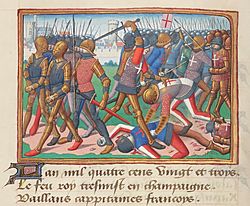Battle of Cravant facts for kids
Quick facts for kids Battle of Cravant |
|||||||
|---|---|---|---|---|---|---|---|
| Part of the Hundred Years' War | |||||||
 |
|||||||
|
|||||||
| Belligerents | |||||||
| Commanders and leaders | |||||||
| Strength | |||||||
| 4,000 • 2,000 English • 2,000 Burgundians |
8,000 • 4,000 French • 4,000 Scots |
||||||
| Casualties and losses | |||||||
| Unknown | 3,200–5,000
1,200–3,000 killed 2,000 captured |
||||||
The Battle of Cravant was a big fight during the Hundred Years' War. It happened on July 31, 1423. English and French armies clashed near the village of Cravant in Burgundy. The battle took place by a bridge and a shallow river crossing on the Yonne River. This river flows into the Seine. The English and their allies from Burgundy won this important battle.
Contents
Why the Battle Happened
After a peace agreement called the Treaty of Troyes in 1420, the English king controlled northern France. But in 1422, King Henry V died suddenly. His baby son, Henry VI of England, became king. This led to fighting starting up again.
In the summer of 1423, the French prince, known as the Dauphin Charles, gathered an army. He wanted to attack Burgundy. This French army included many Scottish soldiers. Sir John Stewart of Darnley led the Scottish troops and the entire French army. There were also soldiers from Spain and Lombardy (a region in Italy). This large army surrounded the town of Cravant.
The people defending Cravant asked for help. The Duchess of Burgundy, Margaret of Bavaria, raised her own troops. She also asked her English allies for support. The English agreed to help. The two allied armies, one English and one Burgundian, met up at Auxerre on July 29.
How the Allies Prepared
The leaders of the English and Burgundian armies held a meeting. This meeting was in Auxerre Cathedral on the evening of July 29. They planned how they would fight. They decided their soldiers would fight on foot, not on horses. Horses would be kept safely behind the lines. Archers were told to prepare sharp wooden stakes. These stakes would help stop enemy horse attacks. That night, the army was told to pray for victory. They planned to start marching at 10 AM the next day.
The Armies Involved
The Allies: England and Burgundy
The combined English and Burgundian forces had about 4,000 soldiers. This included 2,000 Burgundians and 2,000 English. About 1,500 of these were heavily armed soldiers called men-at-arms. The English had 1,500 archers. The Burgundians also had crossbowmen. They even had 40 light cannons, called veuglaires, operated by people from Auxerre. Jean de Toulongeon and Thomas Montacute, 4th Earl of Salisbury led these allied forces. Lord Willoughby was second in command.
The French and Their Allies
The French army was led by Sir John Stewart of Darnley. Louis, Count of Vendôme was his second in command. There were about 4,000 Scottish soldiers. A large French force was also present. Smaller groups of soldiers from Aragon (in Spain) and Lombardy were there too. The French army was much bigger than the allied force. It was perhaps two or three times larger.
The Battle Begins
The allied army marched all day on July 30. That evening, they saw the enemy about 6 kilometers (about 3.7 miles) from Cravant. The next day, the allies thought the French position was too strong. So, they crossed the Yonne River. They tried to reach Cravant from a different direction.
As they approached the town from across the river, the allies saw something. The French army had moved! They were now waiting on the other side of the river. For three hours, both armies just watched each other. Neither side wanted to try crossing the river while the enemy was waiting.
Finally, the Scottish archers started shooting arrows at the allied soldiers. The allied cannons fired back. Their own archers and crossbowmen also began shooting.
Crossing the River
The allied commander, Salisbury, saw that the French were getting hurt and confused. He decided to act. His army began to cross the river. The water was about waist-high and 50 meters (about 164 feet) wide. English archers kept shooting arrows to cover their crossing.
At the same time, another group of allied soldiers, led by Willoughby, attacked the Scots. They crossed a narrow bridge. This attack split the French army in two. The French soldiers started to retreat. But the Scots refused to run away. They kept fighting bravely. Hundreds of them were killed at the bridge or along the riverbanks. Over 2,000 French and Scottish soldiers were captured. This included Darnley, who lost an eye, and the Comte de Vendôme.
While the English and Burgundians were fighting, something else happened. Burgundian knights from inside Cravant rode out of the town. They launched a powerful attack on the French lines. This attack completely broke the French army. Attacked from two sides, the French army ran away from the battlefield.
The French forces retreated towards the Loire River. On August 2, the English and Burgundian armies left Cravant. The Burgundians marched to Dijon. The English went to Montaiguillon.
What Happened Next
The victory at Cravant was the first time English and Burgundian armies fought and won together. Even with this success, they rarely fought side-by-side again. They usually operated separately. The French would suffer an even bigger defeat the next year. This happened at the Battle of Verneuil.
Sources

